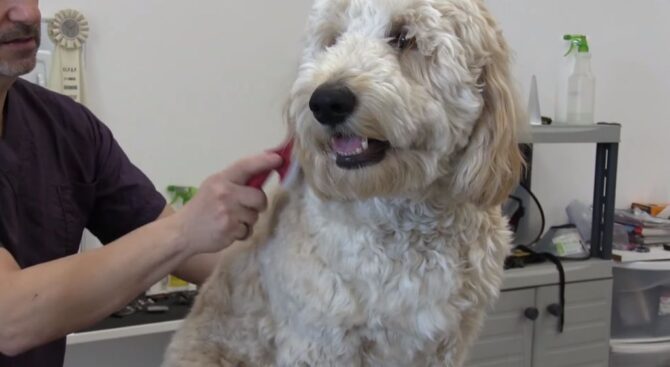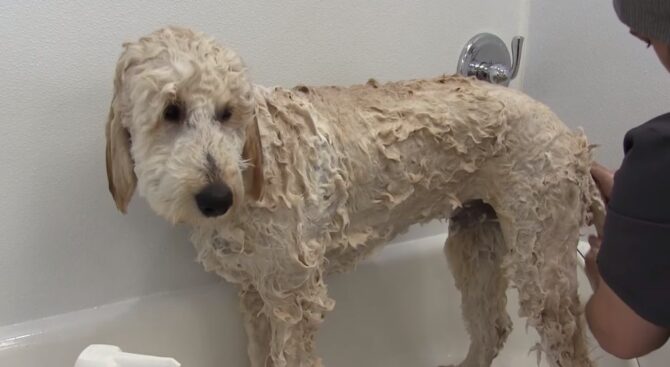The Goldendoodle is one of the most popular breeds today. It represents a mixture of Golden Retriever and Poodle. There are many reasons why so many people are interested in getting one, such as their friendly behavior, intelligence, appearance, and the hypoallergenic coat, which is especially important for those with allergies.
If you are considering getting a dog, keep in mind that it will impact your life in many ways. It is a serious decision and you must take the right approach and secure the right conditions for a new family member. If you are still looking for a place where you can adopt or buy a dog, check out WeLoveDoodles.
The next step is to learn more about the needs of your little friend. When it comes to Goldendoodle, there is a feature that makes it different from other breads, which is the longer coat that should be trimmed from time to time. Learning more about how fast it grows will help you plan to take your dog for grooming.
How Often Will You Visit the Pet Groomer?

The important detail about hair growth is that there are different cycles active in the process. The first one is called anagen, and that represents the first stage when the hair will form. The frequency depends on various factors, and you can expect a rate of one inch per month.
After the initial growth and formation of fur, the next state is the catagen phase. During this stage, the growth rate will slow down significantly. The last one is the telogen phase when the dog is shedding its old fur. During this time, new fur will start growing faster again.
What Can Affect the Growth Rate?
Multiple factors could lead to faster or slower formation of fur. For example, genetics is one of the key factors, especially because the Goldendoodle is a mixture of Golden Lab and Poodle. Therefore, if it catches more of Poodle genes, grooming might be required more frequently.
Other things could also affect the frequency, such as nutrition, health conditions, care, and more. Also, seasonal changes are making a bigger impact. Commonly, the fur will grow longer during summer while slowing down during winter. Shedding is playing a primary role.
A balanced diet rich in proteins, vitamins, and minerals is essential for healthy hair growth. Health issues, such as hormonal imbalances or skin conditions could also affect the state of the fur and rate.
Furthermore, if you are taking your dog to grooming more often, there is a chance that it will motivate a faster growth rate as well. The grooming will stimulate hair follicles. Therefore, prepare to visit pet groomers more often once you start using this service. Also, avoiding bringing your dog for trimming can only lead to issues. The fur can start growing unevenly.
How to Keep It in Perfect Condition?

The key is to be responsible and pay more attention to your dog. After some time, you will recognize a pattern that will help you determine the average frequency between two grooming sessions.
A good-looking and healthy fur is also a sign that your little friend is in a good state. This is important to know since signs on the fur like changes in color and density could represent a potential health issue.
While a pet grooming service is a simple and convenient solution, there are also additional options that you can use at home, such as brushing, bathing, and trimming. Brushing is a simple technique that will remove the excess hair. However, if you notice that more fur is staying on the brush lately, you should take your little friend to the vet.
The bathing depends on the overall conditions where your dog lives. For example, it is not necessary more often if you live in an apartment while having a backyard where your dog spends most of the day should result in more recent baths, especially if you are letting the dog inside. Trimming requires some skills, so start with shorter cuts to avoid mistakes.
There are also standard care practices that will maintain the health of your dog, including good-looking fur. Therefore, a balanced diet, additional supplements, and regular vet visits are a shortcut to the perfect-looking hair for your Goldendoodle.
Should You Let the Hair Grow Longer?
Precisely trimmed fur is the most common decision of many owners. On the other side, some prefer experimenting and making their dogs look more unique. Leaving longer hair is the best way to make your little friend look even more adorable. However, it is questionable how far you should go.
The benefit of letting the fur grow longer is that it will protect your dog in cold weather. On the other hand, be prepared for some downsides of that, such as frequent need for brushing, more dirt caught in the fur, and more.
When you maintain shorter and trimmed fur, it will be easier to keep the dog clean, but also to spot any changes in hair and skin and react on time. Your dog will feel much more comfortable with shorter hair during summer.
The key is that you can play around and let it grow longer, but you should have a limit. Frequent grooming will affect the follicles and faster growth rate. Therefore, once you start with constant trimming, it should remain a habit.
The Bottom Line

As you can see, multiple factors can affect the growth. In most cases, it will be around an inch per month. Therefore, be prepared to take your dog for a grooming session at least once every two months.
You can reduce that by trimming your dog at home, at least from time to time. However, this is never recommended to those without proper skills and experience. In the end, trimming is an essential part of the process where the aim is to maintain the perfect appearance of your little friend.






